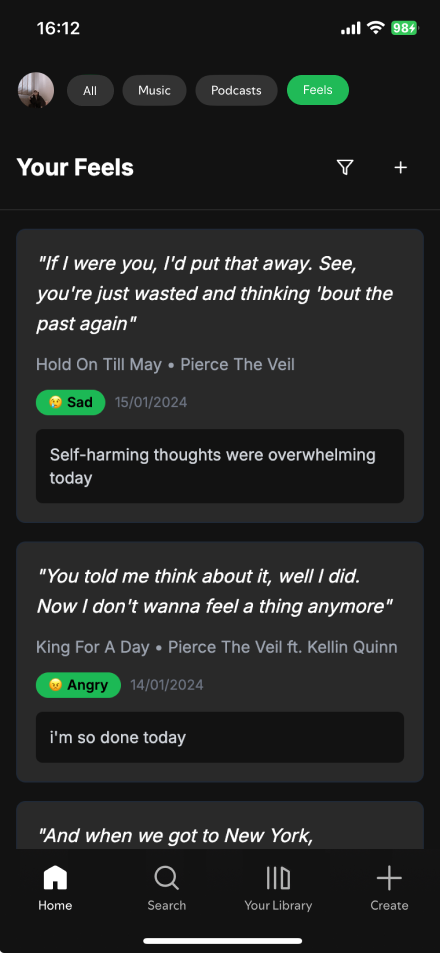UX / UI Case Study | July 2025
Spotify Feels Case Study
Overview:
Spotify Feels is a conceptual feature designed to turn music listening into an emotional journey. It allows users to track moods, highlight meaningful lyrics, and reflect on how music shapes their feelings over time, creating a personal, emotional diary right inside Spotify.
Disclaimer: Spotify Feels is an independent, speculative UX case study created for portfolio purposes. It is not affiliated with, sponsored by, or endorsed by Spotify AB.
Type:
Concept & Feature Design
Role:
UX Research & Insights
Concept Development
User Flow Design
A Generation in Crisis: Rising Mental Illness Rates Plague Gen Z and Millennials
Anxious minds. Endless playlists. A generation overwhelmed by mental health struggles, yet few tools help them decode how they feel.
How might we transform everyday digital experiences into spaces for emotional awareness and self-care?
Concept Inspirations
This idea was inspired by how other apps help users connect emotionally with content:
Kobo e-reader: lets me highlight meaningful text, creating a personal record of moments.
Flo app: marketed as a period tracker, ovulation calculator, and pregnancy companion—that allows you to log symptoms.
Social sharing: many people share songs on Instagram Stories, not just for music, but as emotional signals seeking connection or attention.
Certain songs become soundtracks to heartbreak, anxiety, or sadness. Often reflecting one’s mental state before being fully aware of it.
“What if Spotify combined these ideas: letting me highlight lyrics that hit hardest, and track emotional patterns through music?”
Addressing the Problem
Spotify knows what you’re listening to but not why.
Music is deeply emotional. Many listeners use Spotify for coping, healing, or celebrating. I’ve often wondered: Could my music patterns help me understand my emotional health? Could they even warn me if I’m heading toward a mental breakdown?
Spotify’s current experience focuses on genres, artists, or “time of year” trends (like Wrapped), rather than the emotional context of songs.
Opportunity:
Use music’s emotional impact to boost engagement, support personal growth, and solidify Spotify’s role as a daily essential.
Broader Insights
To validate my own experience, I researched:
Mental health trends among Gen Z and Millennials.
The role of music in emotional coping and mood regulation.
Gaps in current music apps for tracking emotional context.
Key Insights:
Many people use music as an emotional diary, like a catharsis
Listeners want tools for self-awareness and mental health, but privacy is crucial.
There’s growing interest in digital wellness features integrated into daily-use apps.
The Role of Music in Emotional Coping and Mood Regulation
Music helps people manage stress, anxiety, and overwhelming emotions
Certain songs become personal “soundtracks” tied to specific memories or moods
Listeners use music to process breakups, grief, or emotional highs
Repeating favorite tracks can be a self-soothing behavior during difficult times
Music creates a safe space for emotional release and reflection
Solution Approach
My goal was to create a feature that empowers users to reflect on their feelings without leaving their music experience.
Seamless Integration
Designed lightweight flows that fit naturally into Spotify’s UI
Minimal overlays to avoid interrupting music playback
Emotional Clarity
Used mood tags and emojis for quick, intuitive emotional logging
Inspired by highlight interactions from Kobo and mood tracking in Flo
Privacy-First Design
All Feels entries are private by default
Users control if and when to share their emotional data
Lightweight Interaction
Fast, single-tap mood tagging
Optional notes for deeper reflection without pressure
Core Screens
Your Feels (Landing Screen)
Library of saved lyrics and moods
Shows song, mood tag, date, and personal notes
Acts as a private emotional journal
Log Your Feels
Triggered from highlighted lyrics or adding from ‘+’
Pick how lyrics make you feel (e.g. Sad, Happy, Angry)
Optional personal note
Quick save to Feels library
Filter & Sort
Filter saved entries by mood or time period
Helps track emotional patterns over time
Supports self-awareness and mental health insights
Ways to access the feature
Users can access the Feels feature through multiple touchpoints, without disrupting the core listening experience:
From the Home Screen:
A new “Feels” tab at the top of the Home feed dedicated to reviewing saved lyrics, moods, and emotional trends.
While Playing Music:
Users can tap on the lyrics view and select specific lines that resonate with them.
After selecting lyrics, users see sharing options, including “Log Feels,” which launches the mood tagging and journaling flow.
From the Share Sheet:
When sharing a lyric snippet, users can choose “Log Feels” alongside options like Instagram Stories, WhatsApp, or copying a link
Conclusion:
Strategically, the concept deepens engagement, unlocks rich emotional data for personalization, and hints at Spotify’s potential to evolve into a tool for self-awareness and daily wellness.







